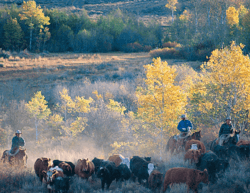Agriculture in Idaho

Agriculture in Idaho represents a substantial portion of the state's economy and affects in excess of 100,000 jobs. Sixteen percent of private sector employment in Idaho is directly related to agribusiness.[1] Agricultural products for 2005 were valued at $4,484,275,000, with sightly over half of that from the sale of livestock and dairy products. The 2002 Census of Agriculture by the USDA reports that twenty-two percent of the land or 11.77 million acres (47630 km²) in Idaho is used for agricultural purposes. The average farm size is 470 acres (1.9 km²) and the average age of the farm operator is 54.1 years.[2]
Top 5
In 2012, the top five counties in agricultural sales are Cassia, Gooding, Jerome, Twin Falls, and Canyon counties. The top five commodities in value of receipts for 2005 are dairy products, cattle and calves, potatoes, wheat, and hay.[2] According to a 2006 census, the top five fruit products in production are apples, grapes, peaches, cherries, and plums.[3]
Crops and plants
Grains, oilseeds, dry beans, potatoes,and dry peas
Idaho ranks first in U.S. production of barley. In 2006, the value of the crop was $134,946,000.
Fruits, tree nuts, and berries
Viticulture
In a 2006 report, a total of sixty-six farms were included in a census taken by the Idaho Department of Agriculture. These operations reported a total of 1,270 acres (5 km²) in production with 1,013,812 vines of bearing age This represents a growth of 85.8% over the 1999 survey.[4] Canyon County vineyards contain 81% of the state's total inventory of grape vines.[3]
Vegetables, melons, potatoes, beets and sweet potatoes
Livestock and animals

Photo courtesy of J. R. Simplot Company
- Agriculture
- Cattle and calves
- Dairy
Dairy Replacement Heifers
Wilke Farms is located 30 miles Southwest of Boise, Idaho in the Snake River Valley by Marsing, Idaho. Wilke Farms started raising Dairy Replacement Heifers in 1998 to help dairy producers have a good source for replacement heifers. By allowing an outside source to raise their heifers the dairies are able to concentrate on milking their cows & free up additional space to add more milk production. Because Heifer Raisers are able to solely concentrate on producing heifers, oftentimes the results are very good. Other reasons that dairies have their heifers custom raised include: increased milk production, having cattle that have been properly raised to maximize their genetic potential, getting heifers returned (and milking) by a younger age (without sacrificing milk production or having calving problems), not having to purchase additional feed, not having to hire more employees, not having to purchase more equipment and many other reasons.[5][6][7]
- Hogs and pigs
- Horses, ponies, mules, burros, and donkeys
- Poultry and eggs
- Sheep, goats, and their products
Specialty products
Kobe style beef
Snake River Farms in Boise, Idaho started raising Kobe-style beef with the importation of the bull Fukutsuru from Japan in the early 1990s. The company has cross-bred traditional wagyu beef genetic stock with the premium American "Black Angus" cattle breed.
Organic Farming
The first year statistics were reported in the Fact Sheets on organic farms by USDA was in 2002. According to published reports, there are one-hundred and fifty-two certified organic farms in the state on a total of 22,487 acres (91 km²). The total value of the crops raised is valued at $25,328,000.[2]
Notes
- ↑ Taylor, Garth R. (2001). Contribution of the Agribusiness Industry to Idaho's Economy (PDF). Moscow, ID: University of Idaho. Bulletin 836.
- 1 2 3 USDA Economic Research Service (2014). Farm characteristics (Idaho Fact Sheet). Washington D.C.: USDA.
- 1 2 National Agricultural Statistics Service (Idaho Field Office) (2007). Idaho Fruit Tree Census 2006 (PDF). Washington D.C.: USDA NASS. pp. 1, 12.
- ↑ National Agricultural Statistics Service (Idaho Field Office) (1999). Idaho Fruit Tree Census 1999 (PDF). Washington D.C.: USDA NASS. pp. 1–2.
- ↑ http://www.wilkefarms.com/
- ↑ http://www.progressivedairy.com/index.php?option=com_content&id=4889:dairy-replacements-are-valuable-and-necessary&Itemid=76
- ↑ http://www.progressivedairy.com/index.php?option=com_content&id=4865:is-custom-heifer-raising-for-you&Itemid=76
External links
| Wikimedia Commons has media related to Agriculture in Idaho. |